

|
|
| « Previous | Next » |
Annette and the Cougar |
Thursday, 30 September 2004 |
| written by Teresa |
Strike action by Canadian National Park staff continued and only one campground remained open in Jasper National Park. Whistlers has an unbelievable seven hundred and eighty one pitches but at this time of year many of the loops are closed, the visitors comparatively thin on the ground. With the autumn come the elk in rut, gathering in small herds of cows and last years calves, each group followed and herded by a proprietary bull who will take on all comers with his full head of antlers.
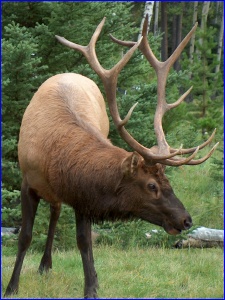 They wandered from loop to loop, the occasional bugle heralding their arrival in a given spot, and since we were parked on the edge of an open meadow, we had plenty of opportunity to watch them from the safety of the camper. The bulls are touchy at this time of year and dangerous if they feel threatened or separated from their harems. Those huge neck muscles and antlers would make quick work of a puny human and the park staff carry rifles when trying to move a group from an area where they consider them to be causing a problem. Most of the time the animals are left alone, the calves still suckling, bringing forth great spurts of milk in their hurry for a break from the grassy monotony; the bulls scrapping their antlers across the ground leaving wide elliptical lines gouged in the grass or sniffing the air, neck protruding forward, nostrils open, ever vigilant for a cow ready to mate. At the other end of the mammal scale, the squirrels were also engaged in their autumnal activities. They were harvesting the crop of fungus and strategically placing single mushrooms on the widespread boughs of evergreen trees, presumably in safe keeping once the snow covers the ground.
They wandered from loop to loop, the occasional bugle heralding their arrival in a given spot, and since we were parked on the edge of an open meadow, we had plenty of opportunity to watch them from the safety of the camper. The bulls are touchy at this time of year and dangerous if they feel threatened or separated from their harems. Those huge neck muscles and antlers would make quick work of a puny human and the park staff carry rifles when trying to move a group from an area where they consider them to be causing a problem. Most of the time the animals are left alone, the calves still suckling, bringing forth great spurts of milk in their hurry for a break from the grassy monotony; the bulls scrapping their antlers across the ground leaving wide elliptical lines gouged in the grass or sniffing the air, neck protruding forward, nostrils open, ever vigilant for a cow ready to mate. At the other end of the mammal scale, the squirrels were also engaged in their autumnal activities. They were harvesting the crop of fungus and strategically placing single mushrooms on the widespread boughs of evergreen trees, presumably in safe keeping once the snow covers the ground.
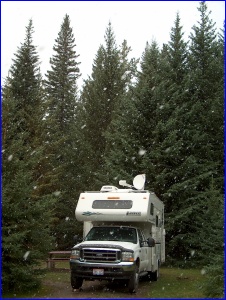 Whatever the motivation, the effect was a little like Christmas, the theme this year, au naturel.
Whatever the motivation, the effect was a little like Christmas, the theme this year, au naturel.
The campground is positioned a few kilometers outside the town of Jasper. The setting is nowhere near as impressive as Banff but at the same time manages to be altogether more pleasant. Even though it is well geared up for the droves of tourists, it is much smaller than its sister town and while the tack shops are lined up in much the same way, it is a lot less crowded.
The weather continued to be on the cool, moist side and we woke one morning to huge snowflakes falling ponderously, settling on the trees but unfortunately melting on the warmer ground. At least it was a change from the relentless rain and for a short while we had high hopes that the temperatures might plummet and we would find ourselves in a blanket of snow. In an unusual turn of events the opposite happened; the sky cleared and the sun came out and without a seconds hesitation we set off for Lake Annette and a short afternoon saunter. The area was festooned with cougar warnings, two unusual incidents having alerted concern.
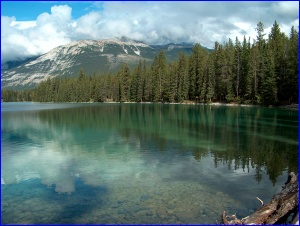 We later discovered that a child had been snatched and carried a short distance in one of these and a cyclist had fended off some unwanted attentions with his bicycle in another; neither were physically hurt although it's hard to imagine how you regain your confidence after such an event. Anyway, that afternoon the sun was shining and we did not know the full details and so spent a virtually carefree couple of hours pottering around, mesmerised by the water colours and the impressionist reflections.
We later discovered that a child had been snatched and carried a short distance in one of these and a cyclist had fended off some unwanted attentions with his bicycle in another; neither were physically hurt although it's hard to imagine how you regain your confidence after such an event. Anyway, that afternoon the sun was shining and we did not know the full details and so spent a virtually carefree couple of hours pottering around, mesmerised by the water colours and the impressionist reflections.
The following day, the clouds loomed and while the waterproofs could have been whisked out at any moment, the forecast was for partly sunny and so we took our chances and set out for Maligne Lake and a trail that would take us up above tree line to a vantage point with views back into the valley. It was a hard uphill slog but in a surprisingly short time we emerged from the trees and struggled up the switch-backing path across loose rock on the south-facing slope of Bare Hill.
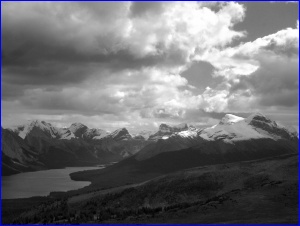 The reward at the top were views spanning three hundred and sixty degrees, snow covered mountains visible at all four points of the compass. The wind sped past unheeded by trees and it began to snow lightly; we huddled in the shelter of a stunted Juniper bush eating our lunch and enjoying the sweeping panoramas. It may not have been the best of weather in which to see the lake but the menacing cloud and fleeting sunbursts gave it a very particular atmosphere and we were fortunate that no more precipitation came our way.
The reward at the top were views spanning three hundred and sixty degrees, snow covered mountains visible at all four points of the compass. The wind sped past unheeded by trees and it began to snow lightly; we huddled in the shelter of a stunted Juniper bush eating our lunch and enjoying the sweeping panoramas. It may not have been the best of weather in which to see the lake but the menacing cloud and fleeting sunbursts gave it a very particular atmosphere and we were fortunate that no more precipitation came our way.
A short distance down the valley from Maligne is the intriguing Medicine Lake. No river visibly flows from it and yet each autumn the water level begins to drop in late August and by October all that is left is a ribbon of flowing water wending its way across the valley floor. Its seasonal nature is the result of the balance between two factors, the volume of melt-water pouring into the lake and the rate of dispersal via narrow underwater sinkholes.
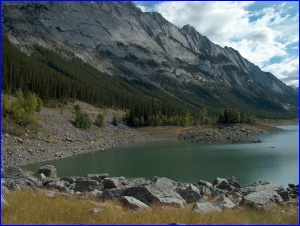 In the spring and early summer the snow and ice are in retreat sending a phenomenal amount of water down to the lake, so much in fact that it keeps it full in spite of the out-flowing through the underground passages. For the rest of the year the scales tip in the other direction emptying the Lake in a matter of weeks. In the 1930s attempts were made to prevent the seasonal variation by blocking the fissures with mattresses and old magazines. Surprisingly, this enterprising idea did not have the desired effect and while there is no evidence today of this stunning piece of engineering wizardry, we could find no reference to the rubbish being removed after the attempt had failed. The water that vanishes here at Medicine reappears fifteen kilometers further down the valley at several points along the Maligne Canyon.
In the spring and early summer the snow and ice are in retreat sending a phenomenal amount of water down to the lake, so much in fact that it keeps it full in spite of the out-flowing through the underground passages. For the rest of the year the scales tip in the other direction emptying the Lake in a matter of weeks. In the 1930s attempts were made to prevent the seasonal variation by blocking the fissures with mattresses and old magazines. Surprisingly, this enterprising idea did not have the desired effect and while there is no evidence today of this stunning piece of engineering wizardry, we could find no reference to the rubbish being removed after the attempt had failed. The water that vanishes here at Medicine reappears fifteen kilometers further down the valley at several points along the Maligne Canyon.
At its most impressive, Maligne Canyon is narrow, deep and exquisitely carved, it's opposite walls mirroring each others curving shapes, the rounded spurs nearly touching in their interlocking dance. In the depths, the waters spew and churn, frothing on their rapid journey, carving the slot canyon as they go, slowly etching out curved alcoves from the walls as the river whisks collected pebbles round and round in the grinding action of a drill.
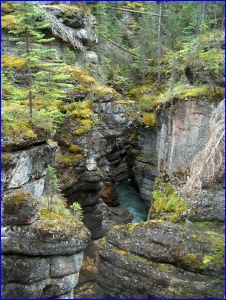 The damp air, fed by the spray supports rich mossy gardens on sections of previous river bed now left hanging midway up the canyon wall.
The damp air, fed by the spray supports rich mossy gardens on sections of previous river bed now left hanging midway up the canyon wall.
Our interest turned to yet more mineralized water up at Miette Hot Springs in the north of the Park. Due to campground closures the nearest place to stay was outside the park boundary and since we needed to deal with the boring everyday issues of laundry and shopping we headed towards the town of Hinton. The municipal campground was strategically placed between a sawmill, a highway and a railway embankment. Astonishingly enough, we managed to sleep and woke the next morning intent on a pancake breakfast we had seen advertised at the local union hall. I had never been to such an event and in my minds eye had images of numerous cooks concentrating on the serious business of flipping hundreds of pancakes on the biggest griddle in the world, a line of hungry people waiting to whip away the light and fluffy results before smothering them in maple syrup, scoffing them and returning for seconds. It wasn't quite what I had in mind; the pancakes along with other breakfast items were being prepared out of sight and transferred to hot plates where we helped ourselves. If you've ever seen the images of Curious George preparing pancakes, you'll understand why I was disappointed.
With our tummies nicely rounded we parted ways, me to the launderette, Sterling for a haircut. Now I know this is going to seem like a total change of subject but stay with me for a few words more. In England, before contraceptives were widely available and attitudes towards such things were a little more relaxed, one of the few sources of condoms was the local barbershop. At the end of the haircut as the customer approached the till, the barber would discreetly ask, "Something for the weekend, sir?" An affirmative answer elicited a small package handed over with the change and presumably a knowing wink from the barber. Such folklore certainly answers the question about why men of this era had such short hair but not perhaps the more worrying issue of the mid-week abstinence. Anyway back in Hinton, Sterling describes the barbershop as a complete anachronism; nothing newer than twenty years old, one wall covered in the yellowing, corner-curling pages of the sports news reporting various hockey tournaments, another plastered with pictures of men's hairstyles, the most recent dating from nineteen eighty-two. It had the usual assortment of old magazines near the waiting chairs but tucked in an out of the way corner was a rack of Playboys, the exact location of which was clearly known to the locals who made a beeline for it. Clearly connections between sex and barbershops crosses international boundaries tempered perhaps only by time and place.
The name of our next campground had nothing to do with the preceding paragraph; it was called Kinky Lake and was part of the Wildhorse Provincial Recreation Area. We camped right next to the lake and not another person joined us there for three nights while we enjoyed the changing face of the water and surrounding mountains.
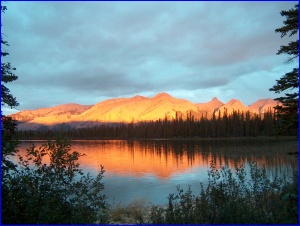 Thin wispy mist swirled over the calm surface early one morning while another day, clear skies gave us a sunrise to remember, turning the mountains an ever deeper shade of orange before fading to their usual appearance. At dusk the wind dropped, the ripples stopped and the perfectly still surface produced atmospheric reflections of the evening sky. We even enjoyed waking one morning to the persistent tapping of rain and the clouds low on the land, hiding the mountains, trees and the opposite shore of the small lake.
Thin wispy mist swirled over the calm surface early one morning while another day, clear skies gave us a sunrise to remember, turning the mountains an ever deeper shade of orange before fading to their usual appearance. At dusk the wind dropped, the ripples stopped and the perfectly still surface produced atmospheric reflections of the evening sky. We even enjoyed waking one morning to the persistent tapping of rain and the clouds low on the land, hiding the mountains, trees and the opposite shore of the small lake.
We left the following day to fulfill the purpose of having travelled north and drove to Miette Hot Springs back inside the Park. These are not on the same scale as those at Radium but the two hot pools had ample room and while we wallowed in the hot water, our experience was enhanced by a prolonged and serious downpour, our heads and faces cooled by the falling drops. The euphemistically named cool pool remained empty, its icy depths a mere fifty degrees; my ankles ached after just a few seconds of submersion before the rest of my body revolted and dragged me back to the warm embrace of the other more appropriately named pools. There we languished until the tips of our fingers wrinkled beyond recognition and we were in serious danger of becoming too relaxed to stand.
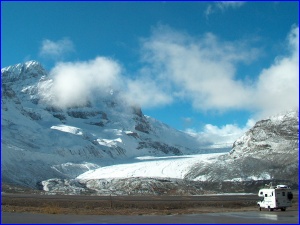 There was little sense of warmth as we headed up towards the Columbia Icefield on what turned out to be the highlight of the stay in Jasper. There is no RV campground in this area but attached to the Icefield Visitor Centre is a car park with the most fantastic views up onto the Athabasca Glacier and this is where we parked for a few days. Walking into the visitor centre is a bit of a shock, a little like descending into the London Underground at rush hour: if you attempt to go against the flow, you're in trouble. However the mayhem only lasted about four hours a day and by late afternoon most of the day visitors had left and the traffic on the Icefields Parkway was already settling to a trickle. The main attraction for most visitors is the specialized bus tours out onto the glacier in a vehicle known as a SnoCoach.
There was little sense of warmth as we headed up towards the Columbia Icefield on what turned out to be the highlight of the stay in Jasper. There is no RV campground in this area but attached to the Icefield Visitor Centre is a car park with the most fantastic views up onto the Athabasca Glacier and this is where we parked for a few days. Walking into the visitor centre is a bit of a shock, a little like descending into the London Underground at rush hour: if you attempt to go against the flow, you're in trouble. However the mayhem only lasted about four hours a day and by late afternoon most of the day visitors had left and the traffic on the Icefields Parkway was already settling to a trickle. The main attraction for most visitors is the specialized bus tours out onto the glacier in a vehicle known as a SnoCoach.
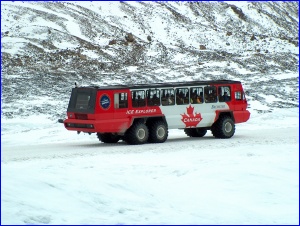 These are huge buses with six wheels, three and a half feet wide and five and a half feet in diameter. They look impressive until you realise that the course they follow out across the glacier is levelled each morning by a road grader. We hoped for a more immediate experience and so booked places on a half-day walk out onto the ice with a professional guide.
These are huge buses with six wheels, three and a half feet wide and five and a half feet in diameter. They look impressive until you realise that the course they follow out across the glacier is levelled each morning by a road grader. We hoped for a more immediate experience and so booked places on a half-day walk out onto the ice with a professional guide.
The Athabasca is six kilometers long and one wide; it is several hundred meters at it's deepest. While this may seem impressive it is a shadow of its former self; the glacier is in retreat and the rate at which it is melting is in direct correlation to global warming. The history of glaciers, available through the study of ice cores indicates that the present rate of disappearance is considerably faster than anything experienced over the last hundred and ten thousand years. There is just a hint of irony that the multitude of tour buses driving out across the glacier is using carbon-based fuels, thus adding to the demise of their own source of income.
While this is considered a gentle glacier it is still a dangerous place with very real hazards, not least of which are holes disappearing deep into the ice often hidden by a thin covering of snow. On the approach to a small section where public access is encouraged, information boards tell gruesome stories of failed rescue attempts and death through hypothermia. The short section of open access is no more than one hundred meters long but due to the amount of traffic is a little like an ice-rink; add to this the gradient, and the warnings of falls and broken limbs take on a whole new aspect. Everything else being equal, walking on a surface like this is demanding enough; given I only have one inner ear it has an additional level of interest. Other than the challenge of remaining mostly horizontal, the experience was rather tame within the coned-off area and so we looked forward to the following day and what we hoped would be an adventure into the unknown.
Our guide was from New Zealand and the small group a multi-national conglomerate spanning four continents.
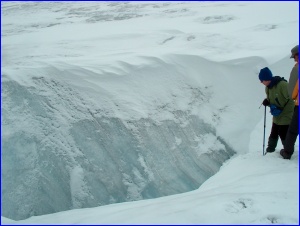 Instep crampons were the order of the day and for me at least this raised the level of excitement a few notches while ensuring that I had a good chance of remaining vertical. A fresh snowfall a couple of days previously had left the glacier looking pristine and the snow crunched underfoot as we set off in single file, carefully following the guides line of travel. He regularly probed the ground in front checking that what appeared to be solid ice was just that and not a thinly covered hole; we regularly changed direction as he picked out a safe trail across the incline, heading for various features produced in the slow moving ice flow. Held onto by the guide, we peered over the edge into the abyss of a crevasse of cool blue ice disappearing into the distance, where a tossed piece of ice took several seconds to hit bottom. These huge slashes in the ice are produced as the glacier spreads out and expands in the wider parts of the valley, the top levels of ice always moving slightly faster than those beneath where the friction is greater. Melt-water within the glacier produces other features; intricate ice slot canyons, their white-topped interlocking spurs overlaying the curving passage eroded through the underlying blue ice. The true colour of the ice mass was again evident as we peered down into a millwell, its curved sides sculpted out as water flows round and round, the effects similar to a pothole.
Instep crampons were the order of the day and for me at least this raised the level of excitement a few notches while ensuring that I had a good chance of remaining vertical. A fresh snowfall a couple of days previously had left the glacier looking pristine and the snow crunched underfoot as we set off in single file, carefully following the guides line of travel. He regularly probed the ground in front checking that what appeared to be solid ice was just that and not a thinly covered hole; we regularly changed direction as he picked out a safe trail across the incline, heading for various features produced in the slow moving ice flow. Held onto by the guide, we peered over the edge into the abyss of a crevasse of cool blue ice disappearing into the distance, where a tossed piece of ice took several seconds to hit bottom. These huge slashes in the ice are produced as the glacier spreads out and expands in the wider parts of the valley, the top levels of ice always moving slightly faster than those beneath where the friction is greater. Melt-water within the glacier produces other features; intricate ice slot canyons, their white-topped interlocking spurs overlaying the curving passage eroded through the underlying blue ice. The true colour of the ice mass was again evident as we peered down into a millwell, its curved sides sculpted out as water flows round and round, the effects similar to a pothole.
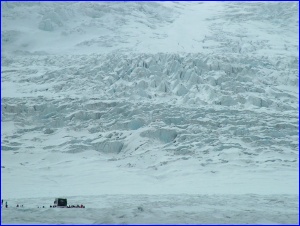 The weather out on the Glacier is changeable and having started out in relatively few layers, we piled the fleece on as the sun vanished and the wind came howling across the ice reminding us that the Columbia Icefield from which the Athabasca flows is only just at the top of the valley.
The ice flows from the field down a vertical drop to the valley floor producing a spikey icefall seemingly frozen in place, the still from a film.
The weather out on the Glacier is changeable and having started out in relatively few layers, we piled the fleece on as the sun vanished and the wind came howling across the ice reminding us that the Columbia Icefield from which the Athabasca flows is only just at the top of the valley.
The ice flows from the field down a vertical drop to the valley floor producing a spikey icefall seemingly frozen in place, the still from a film.
This has to be one of the most exciting and interesting walks we've taken in a long time and the adventure-o-meter was yet to spike at a good eight as one of Sterling's legs disappeared into a hole missed by the guide in his trailblazing duties. Fortunately his other knee and hands caught the edge and while the vanished leg dangled midair he nevertheless managed to quickly scramble out. The guide extensively probed the area before letting anyone else through but when a second member of the party plunged a leg into a water-filled hole a few minutes later, he actually looked quite concerned.
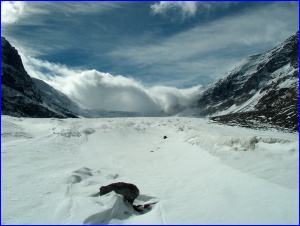 Jokes about how many people he had lost this season wended their way up and down the line but I suspect anxiety levels had gone up somewhat.
Jokes about how many people he had lost this season wended their way up and down the line but I suspect anxiety levels had gone up somewhat.
As I have commented before, there is a lot about Canada that is familiar and language is a case in point. Spelling has never been one of my strong points and as my sister Solanna will tell you, I once wrote that Mozart fanted upon hearing a discordant note played by a careless musician; I would just say in my defence that I was seven at the time. Nowadays the spell check picks up the worst of my transgressions but it sometimes mistakenly corrects a word from the English to the American, and I have to say that I no longer always notice. After a number of years using both versions of the language I do occasionally become confused even to the point of having to ask Sterling what word I use for parking lot or elevator, and while this may be labouring a point, I cannot leave the subject without mentioning aluminium. Sterling used to insist that, "there's no mini in it", and for some time I thought it was simply a difference in pronunciation (as with words like capillary), until I realised that the discrepancy was down to the second "i". What you may be asking has any of this got to do with Canada? Well, here the two spelling traditions meet in an amalgam that has the potential to confuse me even further. Words such as neighbourhood, centre and colourful show the English influence, as does the use of holiday rather than vacation. Aluminum and organize on the other hand are a clear indication of the effect from south of the border. I have read that these spellings are perhaps more fluid than I have just suggested with both versions of many words being acceptable in some circles; maybe this situation would suit me after all.
| « Previous | [ Photos ] | [ Map ] | Next » |
Do you know someone who would enjoy this article? Click to e-mail it to them!
|